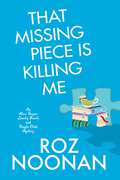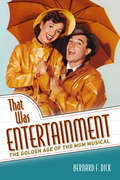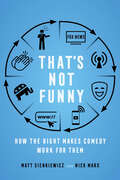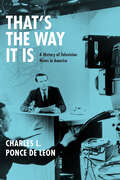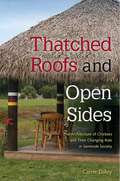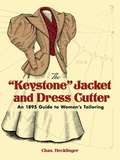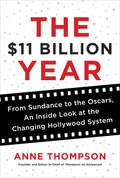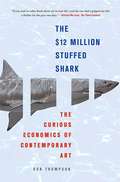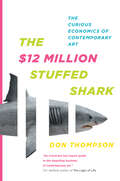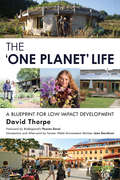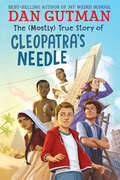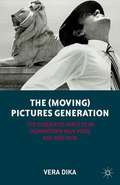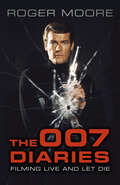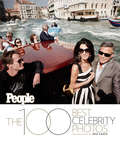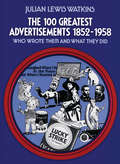- Table View
- List View
That Extra Half An Inch: Hair, Heels and Everything in Between
by Victoria BeckhamI've always been a girls' girl. And I know from experience that making the very best of yourself is something any woman can do. I was never the six-foot-tall pin-up. I've always been the girl-next-door who got lucky. I've come a long way in the last ten years, but this book isn't my attempt to tell you what or what not to do. It's just to share some of what I've learned. In That Extra Half an Inch, a tongue-in-cheek reference to her love of high heels, Beckham shares her tips for finding your own style including: Learning how to dress for special occasions; Shopping for everyday wear and where to look for it; Accessories: defining the looks that work best for you; Helpful hints for the holidays; Making the most of your wardrobe; How to feel confident and look great every time you leave the house. That Extra Half an Inch is a beautiful, nothing-but-the truth, easy-to-use book on fashion, beauty and style. Victoria shares her personal style secrets so whether you're getting ready for work, a night out on the town or even doing the school run, you too can feel confident and look great every time you step out of the front door.
That Missing Piece Is Killing Me (An Alice Pepper Lonely Hearts and Puzzle Club Mystery)
by Roz NoonanSince her divorce, librarian Alice Pepper has had to rethink her golden years. Luckily, she&’s always fit in with a group of puzzle-obsessed friends in the Oregon town of West Hazel. And when a local lady goes missing, Alice must put her curious mind to work to assemble a picture of the woman&’s life—and determine if she&’s a runaway wife or a victim of foul play . . . The owner of a dance and martial arts studio, 63 year-old Michelle Chong is a well-liked fixture in the West Hazel community, despite being married to the famous—and famously temperamental—artist, Lars Olsen. That&’s why when she disappears, people don&’t blame her for fleeing her dysfunctional marriage. Still, Alice has her suspicions, especially after learning about Lars&’ violent past—and current affair. When Alice receives a custom-made puzzle as a gift, the artwork seems so familiar that she assumes it&’s from Lars as an apology for his bad behavior during a recent visit. As she and her friends get to work on it, they&’re stymied by a missing piece. With evidence pointing to Michelle&’s disappearance being planned, Alice turns her attention to her own fractured family. But a shocking chain of events, culminating in a brutal murder, makes Alice question if any piece of the past can ever be put to rest . . .
That Moment When: Life Stories from Way Back Then
by Mo GilliganCome on my journey. Look at where man's come from. I was working in retail in 2017.You might know Mo as the critically acclaimed stand-up comedian, BAFTA-winning presenter, Masked Singer judge and social media mega star. But do you know the moments that really made him? Opening up on the turning points, the good times, the challenges and the lessons learned, this is Mo as you've never seen him before.Journeying through childhood memories in South London, Mo reminisces about school days and old-school raving, and takes us behind the scenes of his first comedy gigs, the creation of the original Geezer, selling out national tours and becoming one of TV's most in-demand stars. Share the moment that Mo decided he wanted to be a comedian, the moment he went viral, the moment he realised he was famous (and how to deal with it), the moment his Netflix special dropped, the moment he won his BAFTA and the moments he still has to come.In among the laugh-out-loud observations, life lessons and candid storytelling, there lies the bigger influences in Mo's life - the unsung heroes of the Black British comedy scene, the power of community and the feel-good legacy he wants to create.'The Funniest Man in Britain' The Times
That Photo Makes Me Hungry: Photographing Food For Fun And Profit
by Andrew ScrivaniDiscover insider secrets for mouthwatering photographs Andrew Scrivani, food photographer for the New York Times, is one of the most respected names in the business. He’s also a teacher of the craft, advising #foodporn obsessives, bloggers, photographers ready for the next step, and anyone who loves to shoot and eat, in how to: See the light (craft and shape it the way you want) Embrace the math (calculate ISO, aperture, shutter speed, and white balance) Consider visual storytelling (single vs. multiple image narratives) Master tricks for shooting in restaurants (window, bounce cards) Be a control freak (shop, prep, cook, style, and shoot) Turn passion into profit (work and get paid) Part straight-forward practical advice, part stories from the field, with many of Scrivani’s signature photos, this book will definitely make you hungry.
That They Lived: African Americans Who Changed the World (Painted Turtle)
by Rochelle Riley Cristi Smith-JonesIn February 2017, Rochelle Riley was reading Twitter posts and came across a series of black-and-white photos of four-year-old Lola dressed up as different African American women who had made history. Rochelle was immediately smitten. She was so proud to see this little girl so powerfully honor the struggle and achievement of women several decades her senior. Rochelle reached out to Lola’s mom, Cristi Smith-Jones, and asked to pair her writing with Smith-Jones’s incredible photographs for a book. The goal? To teach children on the cusp of puberty that they could be anything they aspired to be, that every famous person was once a child who, in some cases, overcame great obstacles to achieve. That They Lived: African Americans Who Changed the World features Riley’s grandson, Caleb, and Lola photographed in timeless black and white, dressed as important individuals such as business owners, educators, civil rights leaders, and artists, alongside detailed biographies that begin with the figures as young children who had the same ambitions, fears, strengths, and obstacles facing them that readers today may still experience. Muhammad Ali’s bike was stolen when he was twelve years old and the police officer he reported the crime to suggested he learn how to fight before he caught up with the thief. Bessie Coleman, the first African American female aviator, collected and washed her neighbors’ dirty laundry so she could raise enough money for college. When Duke Ellington was seven years old, he preferred playing baseball to attending the piano lessons his mom had arranged. That They Lived fills in gaps in the history that American children have been taught for generations. For African American children, it will prove that they are more than descendants of the enslaved. For all children, it will show that every child can achieve great things and work together to make the world a better place for all. That They Lived was made possible through a grant provided by the Community Foundation for Southeast Michigan.
That Was Entertainment: The Golden Age of the MGM Musical
by Bernard F. DickThat Was Entertainment: The Golden Age of the MGM Musical traces the development of the MGM musical from The Broadway Melody (1929) through its heyday in the 1940s and 1950s and its decline in the 1960s, culminating in the notorious 1970 MGM auction when Judy Garland's ruby slippers from The Wizard of Oz, Charlton Heston's chariot from Ben-Hur, and Fred Astaire's trousers and dress shirt from Royal Wedding vanished to the highest bidders.That Was Entertainment uniquely reconstructs the life of Arthur Freed, whose unit at MGM became the gold standard against which the musicals of other studios were measured. Without Freed, Judy Garland, Gene Kelly, Fred Astaire, Ann Miller, Betty Garrett, Cyd Charisse, Arlene Dahl, Vera-Ellen, Lucille Bremer, Gloria DeHaven, Howard Keel, and June Allyson would never have had the signature films that established them as movie legends.MGM's past is its present. No other studio produced such a range of musicals that are still shown today on television and all of which are covered in this volume, from integrated musicals in which song and dance were seamlessly embedded in the plot (Meet Me in St. Louis and Seven Brides for Seven Brothers) to revues (The Hollywood Revue of 1929 and Ziegfeld Follies); original musicals (Singin' in the Rain, Easter Parade, and It's Always Fair Weather); adaptations of Broadway shows (Girl Crazy, On the Town, Show Boat, Kiss Me Kate, Brigadoon, Kismet, and Bells Are Ringing); musical versions of novels and plays (Gigi, The Pirate, and Summer Holiday); operettas (the films of Jeanette MacDonald and Nelson Eddy); mythico-historical biographies of composers (Johann Strauss Jr. in The Great Waltz and Sigmund Romberg in Deep in My Heart); and musicals featuring songwriting teams (Rodgers and Hart in Words and Music and Kalmar and Ruby in Three Little Words), opera stars (Enrico Caruso in The Great Caruso and Marjorie Lawrence in Interrupted Melody), and pop singers (Ruth Etting in Love Me or Leave Me). Also covered is the water ballet musical--in a class by itself--with Esther Williams starring as MGM's resident mermaid. This is a book for longtime lovers of the movie musical and those discovering the genre for the first time.
That's Amore: A Son Remembers Dean Martin
by Christopher Smith Ricci MartinRicci Martin takes readers on a tour through his childhood, from the star-studded parties to the exploration of three marriages, eight kids, one family, to the treasured one-on-one time he shared with his father.
That's Not Funny: How the Right Makes Comedy Work for Them
by Matt SienkiewiczA rousing call for liberals and progressives to pay attention to the emergence of right-wing comedy and the political power of humor. "Why do conservatives hate comedy? Why is there no right-wing Jon Stewart?" These sorts of questions launch a million tweets, a thousand op-eds, and more than a few scholarly analyses. That's Not Funny argues that it is both an intellectual and politically strategic mistake to assume that comedy has a liberal bias. Matt Sienkiewicz and Nick Marx take readers––particularly self-described liberals––on a tour of contemporary conservative comedy and the "right-wing comedy complex." In That's Not Funny, "complex" takes on an important double meaning. On the one hand, liberals have developed a social-psychological complex—it feels difficult, even dangerous, to acknowledge that their political opposition can produce comedy. At the same time, the right has been slowly building up a comedy-industrial complex, utilizing the humorous, irony-laden media strategies of liberals such as Jon Stewart, Samantha Bee, and John Oliver to garner audiences and supporters. Right-wing comedy has been hiding in plain sight, finding its way into mainstream conservative media through figures ranging from Fox News's Greg Gutfeld to libertarian podcasters like Joe Rogan. That's Not Funny taps interviews with conservative comedians and observations of them in action to guide readers through media history, text, and technique. You will find many of these comedians utterly appalling, some surprisingly funny, and others just plain weird. They are all, however, culturally and politically relevant—the American right is attempting to seize spaces of comedy and irony previously held firmly by the left. You might not like this brand of humor, but you can't ignore it.
That's What Fashion Is: Lessons and Stories from My Nonstop, Mostly Glamorous Life in Style
by Joe ZeeJoe Zee, the Editor in Chief of Yahoo Style, former creative director of ELLE magazine, and co-host of the new ABC talk show FAB Life, takes readers behind the scenes of the crazy and wonderful world of fashion in That's What Fashion Is, packed with never-before-seen color photographs from Joe's personal collection. From his early years styling shoots for Vanity Fair's "Hollywood" issue with famed photographer Annie Leibovitz to his role playing himself on MTV's reality show The City to making celebrities look fabulous in the pages of ELLE and reporting live from the red carpet. Joe lets readers in on how the fashion industry really works, from the fashion disasters to the blockbuster successes. How do you shoot an entire magazine spread in Paris in 24 hours? What's a stylist to do when he receives a panicked call from a dress-less Cameron Diaz on Oscar day? And how do they make those celebrities look so great in the magazines? These first-person stories are combined with accessible and practical tips for women everywhere, including what to wear on your first day of work, how to take a great selfie, and how to look amazing at any age. For the first time, this ultimate fashion insider lets readers in on tales, tricks, and tips previously known only to the fashion elite in this funny and frank book.
That's the Way It Is: A History of Television News in America
by Charles L. Ponce de LeonWhen critics decry the current state of our public discourse, one reliably easy target is television news. It s too dumbed-down, they say; it s no longer news but entertainment, celebrity-obsessed and vapid. The critics may be right. But, as Charles L. Ponce de Leon explains in "That s the Way It Is," TV news has "always" walked a fine line between hard news and fluff. The familiar story of decline fails to acknowledge real changes in the media and Americans news-consuming habits, while also harking back to a golden age that, on closer examination, is revealed to be not so golden after all. Ponce de Leon traces the entire history of televised news, from the household names of the late 1940s and early 50s, like Eric Sevareid, Edward R. Murrow, and Walter Cronkite, through the rise of cable, the political power of Fox News, and the satirical punch of Colbert and Stewart. He shows us an industry forever in transition, where newsmagazines and celebrity profiles vie with political news and serious investigations. The need for ratings success and the lighter, human interest stories that can help bring it Ponce de Leon makes clear, has always sat uneasily alongside a real desire to report hard news. Highlighting the contradictions and paradoxes at the heart of TV news, and telling a story rich in familiar figures and fascinating anecdotes, "That s the Way It Is" will be the definitive account of how television has showed us our history as it happens. "
Thatched Roofs and Open Sides: The Architecture of Chickees and Their Changing Role in Seminole Society
by Carrie DilleySoutheast Chapter of the Society of Architectural Historians Award of Excellence for a Book In Thatched Roofs and Open Sides, Carrie Dilley reveals the design, construction, history, and cultural significance of the chickee, the unique Seminole structure made of palmetto and cypress. Dilley illustrates how the multipurpose structure has developed over time to meet the changing needs of the Seminole Tribe.
The "Keystone" Jacket and Dress Cutter: An 1895 Guide to Women's Tailoring
by Chas HecklingerAs the 20th century dawned, women began to abandon frilly fashions for sharply tailored suits. Professional tailors of the time turned to this comprehensive resource to create office outfits, riding pants, blouses, and other garments. Filled with more than 80 patterns, it's an invaluable reference for costume designers and fashion historians. 92 black-and-white illustrations.
The $11 Billion Year: From Sundance to the Oscars, an Inside Look at the Changing Hollywood System
by Anne Thompson"This chronicle of 2012 is a slice of what happened during a watershed year for the Hollywood movie industry. It's not the whole story, but it's a mosaic of what went on, and why, and of where things are heading."What changed in one Hollywood year to produce a record-breaking box office after two years of decline? How can the Sundance Festival influence a film's fate, as it did for Beasts of the Southern Wild and Searching for Sugar Man, which both went all the way to the Oscars? Why did John Carter misfire and The Hunger Games succeed? How did maneuvers at festivals such as South by Southwest (SXSW), Cannes, Telluride, Toronto, and New York and at conventions such as CinemaCon and Comic-Con benefit Amour, Django Unchained, Moonrise Kingdom, Silver Linings Playbook, Les Misérables, The Life of Pi, The Avengers, Lincoln, and Argo? What jeopardized Zero Dark Thirty's launch? What role does gender bias still play in the industry? What are the ten things that changed the 2012 Oscar race?When it comes to film, Anne Thompson, a seasoned reporter and critic, addresses these questions and more on her respected daily blog, Thompson on Hollywood. Each year, she observes the Hollywood machine at work: the indies at Sundance, the exhibitors' jockeying at CinemaCon, the international scene at Cannes, the summer tentpoles, the fall's "smart" films and festivals, the family-friendly and big films of the holiday season, and the glamour of the Oscars®. Inspired by William Goldman's classic book The Season, which examined the overall Broadway scene through a production-by-production analysis of one theatrical season, Thompson had long wanted to apply a similar lens to the movie business. When she chose 2012 as "the year" to track, she knew that box-office and DVD sales were declining, production costs were soaring, and the digital revolution was making big waves, but she had no idea that events would converge to bring radical structural movement, record-setting box-office revenues, and what she calls "sublime moviemaking."Though impossible to mention all 670-plus films released in 2012, Thompson includes many in this book, while focusing on the nine Best Picture nominees and the personalities and powers behind them. Reflecting on the year, Thompson concludes, "The best movies get made because filmmakers, financiers, champions, and a great many gifted creative people stubbornly ignore the obstacles. The question going forward is how adaptive these people are, and how flexible is the industry itself?"
The $12 Million Stuffed Shark: The Curious Economics of Contemporary Art
by Don ThompsonWhy would a smart New York investment banker pay $12 million for the decaying, stuffed carcass of a shark? By what alchemy does Jackson Pollock's drip painting No. 5, 1948 sell for $140 million? Intriguing and entertaining, The $12 Million Stuffed Shark is a Freakonomics approach to the economics and psychology of the contemporary art world. Why were record prices achieved at auction for works by 131 contemporary artists in 2006 alone, with astonishing new heights reached in 2007? Don Thompson explores the money, lust, and self-aggrandizement of the art world in an attempt to determine what makes a particular work valuable while others are ignored. This book is the first to look at the economics and the marketing strategies that enable the modern art market to generate such astronomical prices. Drawing on interviews with both past and present executives of auction houses and art dealerships, artists, and the buyers who move the market, Thompson launches the reader on a journey of discovery through the peculiar world of modern art. Surprising, passionate, gossipy, revelatory, The $12 Million Stuffed Shark reveals a great deal that even experienced auction purchasers do not know.
The $12 Million Stuffed Shark: The Curious Economics of Contemporary Art
by Don ThompsonThe $12 Million Stuffed Shark delves into the economics and psychology of the contemporary art world – artists, dealers, auction houses, and wealthy collectors. If it’s true – as so often said – that 85 percent of new contemporary art is bad, why were record prices achieved at auction for works by 131 contemporary artists in 2006 alone, with astonishing new heights reached in 2007? The $12 Million Stuffed Shark explores money, lust, and the self-aggrandizement of possession in an attempt to determine what makes a particular work of art valuable while others are ignored. In the style of the bestselling Freakonomics, Thompson uses economic concepts to explain the unique practices employed, to great success, in the international contemporary art market. He discusses branding and marketing and how various strategies are tailored to a wealthy clientele, driving a "must-have" culture. Drawing on exclusive interviews with both past and present executives of auction houses and art dealerships, artists, and the buyers who move the market, Thompson launches the reader on a surprising journey of discovery.
The 'Female' Dancer: a soma-scientific approach
by Claire Farmer Helen KindredThe 'Female' Dancer aims to question dancers’ relationships with ‘female’ through the examination and understandings of biological, anatomical, scientific, and self-social identity. The volume gathers voices of dance scientists, dance scholars, somatic practitioners, and dance artist-educators, to discuss some of the complexities of identities, assumptions and perceptions of a female dancing body in an intersectional and practically focused manner.The book weaves a journey between scientific and somatic approaches to dance and to dancing. Part I: 'Bodily Knowledge' explores body image, hormones and puberty, and discussions around somatic responses to the concept of the gaze. Part II: 'Moving through Change', continues to look at strength, musculature, and female fragility, with chapters interrogating practice around strength training, the dancer as an athlete, the role of fascia, the pelvic floor, pregnancy and post-partum experiences and eco-somatic perceptions of feminine. In 'Taking up Space', Part III, chapters focus on social-cultural and political experiences of females dancing, leadership, and longevity in dance. Part IV: 'Embodied Wisdom' looks at reflections of the Self, physiological, social and cultural perspectives of dancing through life, with life’s seasons from an embodied approach.Drawing together lived experiences of dancers in relationship with scientific research, this book is ideal for undergraduate students of dance, dance artists, and researchers, as well as providing dancers, dance teachers, healthcare practitioners, company managers and those in dance leadership roles with valuable information on how to support female identifying dancers through training and beyond.
The 'One Planet' Life: A Blueprint for Low Impact Development
by David ThorpeThe One Planet Life demonstrates a path for everyone towards a way of life in which we don’t act as if we had more than one planet Earth. The difference between this approach and others is that it uses ecological footprint analysis to help to determine how effective our efforts are. Much of the book is a manual – with examples – on how to live the 'good life' and supply over 65% of your livelihood from your land with mostly positive impacts upon the environment. It examines the pioneering Welsh policy, One Planet Development, then considers efforts towards one planet living in urban areas. After a foreword by BioRegional/One Planet Living co-founder Pooran Desai and an introduction by former Welsh environment minister Jane Davidson, the book contains: An essay arguing that our attitude to planning, land and development needs to change to enable truly sustainable development. Guidelines on finding land, finance, and creating a personal plan for one planet living. Detailed guides on: sustainable building, supplying your own food, generating renewable energy, reducing carbon emissions from travel, land management, water supply and waste treatment. 20 exemplary examples at all scales – from micro-businesses to suburbs – followed by Jane Davidson’s Afterword. The book will interest anyone seeking to find out how a sustainable lifestyle can be achieved. It is also key reading for rural and built environment practitioners and policy makers keen to support low impact initiatives, and for students studying aspects of planning, geography, governance, sustainability and renewable energy.
The 'Small Landscape' Prints in Early Modern Netherlands (Visual Culture in Early Modernity)
by Alexandra OnufIn 1559 and 1561, the Antwerp print publisher Hieronymus Cock issued an unprecedented series of landscape prints known today simply as the Small Landscapes. The forty-four prints included in the series offer views of the local countryside surrounding Antwerp in simple, unembellished compositions. At a time when vast panoramic and allegorical landscapes dominated the art market, the Small Landscapes represent a striking innovation. This book offers the first comprehensive analysis of the significance of the Small Landscapes in early modern print culture. It charts a diachronic history of the series over the century it was in active circulation, from 1559 to the middle of the seventeenth century. Adopting the lifespan of the prints as the framework of the study, Alexandra Onuf analyzes the successive states of the plates and the changes to the series as a whole in order to reveal the shifting artistic and contextual valences of the images at their different moments and places of publication. This unique case study allows for a new perspective on the trajectory of print publishing over the course of the late sixteenth and early seventeenth centuries across multiple publishing houses, highlighting the seminal importance of print publishers in the creation and dissemination of visual imagery and cultural ideas. Looking at other visual materials and contemporary sources – including texts as diverse as humanist poetry and plays, agricultural manuals, polemical broadsheets, and peasant songs – Onuf situates the Small Landscapes within the larger cultural discourse on rural land and the meaning of the local in the turbulent early modern Netherlands. The study focuses new attention on the active and reciprocal intersections between printed pictures and broader cultural, economic and political phenomena.
The (Mostly) True Story of Cleopatra's Needle
by Dan GutmanFrom the author of the My Weird School books, an adventure story that spans centuries and continents.In Central Park, New York, stands Cleopatra&’s Needle. But what do you know about? Did you know that thousands of people worked in 1461 BCE to build it? Then hundreds more moved it, and erected it in Alexandria, where it stood for 3,000 years? So how did a monolith weighing over 200 tons get moved all the way to New York City—and in the 19th Century, no less? In this historical fiction account by bestselling author Dan Gutman, five kids who watched the Needle at each phase of its history recount the daring story of how something that seemed to be impossible –and that nearly ended in disaster—finally succeeded against all odds. Including photos, diagrams, and illustrations, this book will leave history lovers and fans of problem solving astounded at all that was accomplished. And best of all, it will leave middle grade readers feeling they&’ve just watched a really good movie—they&’ll hardly even realize they were reading.A Junior Library Guild Gold Standard Selection
The (Moving) Pictures Generation
by Vera DikaBeginning in the late 1970s, a number of visual artists in downtown New York City returned to an exploration of the cinematic across mediums. Vera Dika considers their work within a greater cultural context and probes for a deeper understanding of the practice.
The (Post) Mistress
by Tomson HighwayMarie-Louise Painchaud has worked for thirty-five years as post mistress at the post office in Lovely, a francophone Canadian village where she has come to know every client whose mail she handles. The (Post) Mistress is a rollicking, emotional rollercoaster-ride in the form of a one-woman musical, with elements of jazz, Berlin cabaret, French café music, and Brazilian samba.
The 007 Diaries: Filming Live and Let Die
by Roger Moore David HedisonOut of print for over forty years, The 007 Diaries introduces Roger Moore’s James Bond Diary to a new generation of fans. To tie in with the release of his first James Bond film, Live and Let Die, Roger Moore agreed to keep a day-by-day diary throughout the film’s production, which would be published just ahead of the premiere in July 1973. From his unveiling as the new 007 in 1972 through to his first scenes on location in New Orleans and his final shot in New York, Moore describes his whirlwind journey as cinema’s most famous secret agent. Taking in the sights of Jamaica before returning to Pinewood Studios, Moore’s razor wit and unique brand of humour is ever present. With tales from every location, including his encounters with his co-stars and key crew members, Moore offers the reader an unusually candid, amusing and hugely insightful behind-the-scenes look into the world’s most successful film franchise.
The 10 Cent Chocolate Tub
by Mike Mcgann10 Cent Chocolate Tub will take you back to the 1950's and 1960s when life was uncomplicated. There were three channels to watch on a black and white television set showing Sid Caesar, Bishop Fulton J. Sheen, Howdy Doody, Milton Berle, fifteen minutes of Nat King Cole, The Lone Ranger and The Toast of The Town. Radio stations were AM only and played Elvis Presley, Doo-Wop music, Frank Sinatra, Doris Day, Patti Page, Chubby Checker and The Four Seasons, long before The Beatles came to America. The small things in life were exciting to a city boy who grew up to be a broadcaster, a Vietnam veteran, a minor performer and a dad! Everyone has family stories, crazy relatives, funny incidents, memories of how good things were back then and dreams of how they should be. The 10 Cent Chocolate Tub gets it's name from a huge chocolate ice cream cone sold by Bard's Dairy in the 1950s in Pittsburgh at a time when a young boy, who wore rummage sale clothes and ate surplus cheese, was only allowed a nickel vanilla ice cream now and then. This is about the quest for life's finer things like ice cream anytime you want it, playing the radio loudly, crying at a sad movie, falling in love, heartbreaks, kissing your children goodnight and loving every minute of it.
The 100 Best Celebrity Photos: And The Surprising Stories Behind Them
by The Editors of PEOPLESince its first issue debuted with a Great Gatsby portrait of Mia Farrow, People magazine has delivered not only outstanding celebrity journalism, but also the best in personality photography. Now, the Editors of People present The 100 Best Celebrity Photos.From a Marilyn Monroe pin-up to an internet-breaking Kim Kardashian Instagram, from Harry Benson's exuberant snaps of The Beatles' first visit to America to Bradley Cooper's star-packed Oscar selfie, these are the images that influenced how we understand fame and glamor.Included with each picture is the story behind it: A-list photographers tell how they created the images that turned stars into icons, or made legends seem as relatable as family. Here also are People exclusives from the magazine's history of unparalleled access into celebrity homes and off-duty lives that show us the real side of the stars who most captivate and intrigue us.
The 100 Greatest Advertisements 1852-1958: Who Wrote Them and What They Did
by Julian WatkinsStyles in advertising will change, but there is no copywriter, artist, or campaign planner who will not profit by studying proved successes, whether of 50 years ago or today. In this single volume are 100 of what are probably among the most successful advertisements ever to appear in print, plus an additiional 13 added especially for this edition. These 113 ads are proven salesmen-almost every one had phenomenal results. They have not been included because of personal whim, or for their beauty. The ultimate criterion here is the only one that really counts: whether an ad did what it was supposed to do. These ads helped change the habits of a nation, built reputations, gave new expressions to the language and-first and foremost-sold millions of dollars of merchandise, from Rolls Royce automobiles to Lux Soap, from Riviera Pears to Steinway Pianos. You learn the salient facts behind these ads as well, often expressed in the words of the originator himself. Men who understood intuitively the workings of mass persuasion techniques long before they became widespread describe their own thoughts, reasonings, and hunches. Earnest Elmo Calkins tells about his experiences in creating Phoebe Snow for the Lackawanna Railroad. Bruce Barton tells about his work on the "Five Foot Shelf" ad, which increased eight-fold the number of coupons received. David Ogilvy describes his campaigns for Hathaway Shirts and Rolls Royce. Raymond Rubicam tells of Squibb's "Priceless Ingredient." More than 100 ads tell better than any textbook or professional analysis exactly what is the secret ingredient that makes an ad "click" when a thousand others fail.

